
Publisher:
Bonnie King
CONTACT:
Newsroom@Salem-news.com
Advertising:
Adsales@Salem-news.com

~Truth~
~Justice~
~Peace~
TJP
May-12-2010 14:22

 TweetFollow @OregonNews
TweetFollow @OregonNews
'Manila John' Basilone, USMC
Robert O'Dowd Salem-News.comWilliam Douglas Lansford’s account of Basilone’s life is written by another Iwo Jima Marine who served with Basilone and survived the war to write about it.
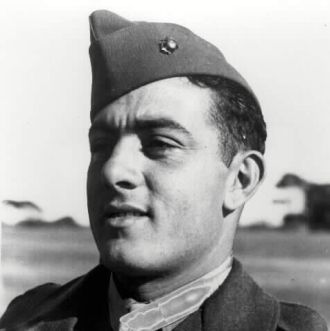 Photos courtesy: U.S. Marine Corps, Arlington National Cemetery and Russell C. Jacobs, March 2006 |
(LOS ANGELES) - ‘Manila John’ Basilone’s name resonates with Marines, but except for some who live in his hometown of Raritan, New Jersey, it’s probably not familiar to many other Americans.
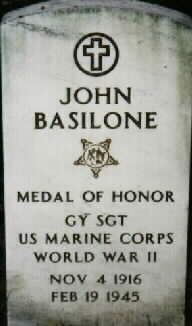
For most younger Americans today, WWII is ancient history. Enter Steven Spielberg and the magic of film.
HBO’s minseries, “The Pacific,” directed by Steven Spielberg, brings the horrors of the Pacific War into homes—absent the smells of rotten corpses and sulfur, jarring concussions of explosives and the gut retching fear of death. One of the Marines featured in the HBO series is ‘Manila John’ Basilone, recipient of the Medal of Honor, Navy Cross, and Purple Heart.
I was born in October 1942. I have no memory of WW II, but do remember the generation of men who fought in this epic conflict. One high school teacher jumped into Normandy with the 82nd Airborne; others served on submarines in the Pacific and flew in bombers and fighters in the Army Air Corps. My family served in all branches of the Armed Services. As a Marine in the 1960s, I served under men who fought in WW II. Most of their names and faces have disappeared from my memory, but not their deeds.
The Pacific War fought by a Japanese military imbued with Bushido code was a brutal and violent conflict. Very few Japanese prisoners were taken. For one of my uncles, the memory of Peleliu, featured in the HBO miniseries, was a recurrent nightmare he carried for the rest of his life.
Major General William Rupertus, commander of 1st Marine Division, predicted Peleliu would be secured within four days. He was wrong. It took over two months and thousands of American casualties (6,500 Marines and 3,300 soldiers from the Army’s 81st Infantry Division). A heavy price to pay for one island and the Pacific War had landings on many islands by both Marines and the Army. For my uncle, a Navy veteran of the Pacific, the death of his 19-year old kid brother on Peleliu was a pain he never forgot.
Boot camp recruits know the names and history of Marines like ‘Manila John’ Basilone, Chesty Puller. Lou Diamond. These men are part of the Marine Corps history and tradition. Like your rifle and service number, all Marines can recite a thumbnail history of these men. I guarantee that any recruit who had a ‘memory lapse’ during an inspection underwent a very short learning curve.
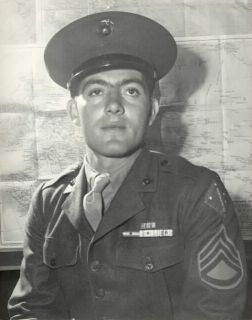
Winner of the Medal of Honor (Guadacanal) and Navy Cross (Iwo Jima), ‘Manila John’ Basilone was killed on Iwo Jima on February 19, 1945. Basilone was 28 years old when killed on Iwo. Not very old. He didn’t have to die on Iwo.
In fact, Gunny Basilone asked go back into combat after turning down a commission and raising over $1,400,000 in a WW II War Bond drive. He was recently married. He didn’t have to prove anything to himself or anybody else. His badge of courage was earned on Guadacanal in 1942. When asked, Basilone, said, “I’m staying with my boys. They need me.” His boys would indeed need him on Iwo Jima. ‘Manila John’ didn’t let them down.
Many in today’s ‘Generation Me’ would have not understand the dedication to duty that drove ‘Manila John’ to volunteer to go back to take care of his boys. For ‘Generation Me’ group born in the 1970s, 1980s, or 1990s , taking care of self comes first. If ‘Manila John’ could come back to life today, he would be dumbfounded by the ‘Generation Me’ attitude.
William Douglas Lansford, another Marine veteran of the Pacific War, served under Gunny Basilone. Lansford’s article, “The Life and Death of “Manila John” was republished in the LA Times on May 3, 2010. Spielberg’s miniseries keeps close to Lansford story with a few exceptions.
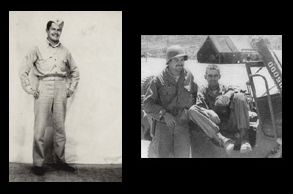 William Douglas Lansford |
Lansford enlisted in the Marines in 1940 and served with the 1st Provisional Marine Brigade in Iceland, the 2nd Marine Raider Battalion on Guadalcanal, and Bougainville and in the 5th Marine Division on Iwo Jima. After the war, he attended college on the G.I. bill and worked as a reporter for the Los Angeles Daily News. He’s written many publications for magazines, several non-fiction books and screenplays.
The following is an excerpt from Landsford’s account of ‘Manila John’ Basilone:
“In 1944, Camp Pendleton could boast of numerous well-stocked slop chutes. It was in one of these that I noticed a jug-eared young gunny who wore his cap sideways, drank beer with the gusto of a millionaire guzzling champagne and laughed so infectiously that one couldn’t help liking him on sight. There was no cascade of decorations on his chest. He looked like no colossus who could dash about loaded with ammo belts, spitting death from machine guns cradled in his Brawny arms.”
The next day I saw him in front of the barracks, holding machine-gun drill. His cap was on straight, and he greeted me with the ease of an old friend:”You’re the new corporal, eh? It’s time to secure the butts. Wanna make a run to the slop chute?” I admitted the notion had crossed my mind. Basilone’s service record book described him as pretty average: “ruddy, medium build, height: 5 feet 8 1/2 inches, weight: 158 pounds,” which certainly matched the guy I’d just met. Yet I had no doubt that this happy warrior was the “muscular giant” gloriously depicted in oils on a recent cover of Collier’s magazine. The tiny blue ribbon spangled with white stars hung above the ribbons for his Presidential Unit Citation, American Defense Service Medal and Asiatic-Pacific Campaign Medal.
Our meeting launched a friendship I will always value. Roy Elsner of Odessa, Texas, had a different take on Basilone: “I was a headquarters cook, and every day I’d see Basilone drilling you guys next to the barracks, but I never dared talk to John. I was only a private, and he was a big hero.
Basilone did more than drill us. He taught our recruits the meaning of esprit de corps, and in those of us who had fought, he rekindled a desire to fight again. His simplicity, his cheerfulness, his grasp of human nature the charm and easy grace with which he carried his honors gave us not only confidence, but pride. We were “Basilone’s boys” and envied for it.
Despite John’s reluctance to play the hero, he’d picked up some useful lessons. When one of his boys was tossed in the brig, or lodged in the San Diego calaboose, Basilone would pick up a phone: “This is Gunnery Sergeant John Basilone,” he’d announce. “I understand ya got one of my kids. I’d appreciate your turnin’ him loose. I got a special mission for him.” No general, provost marshal or police chief could resist the old Basilone charm or The Medal.
Early that summer of 1944 it suddenly ended. We’d been alerted. Between 22 July and 12 Aug., the division began leaving San Diego by regiments for Hawaii. Camp Tarawa a pile of tents in the middle of the Parker Ranch in Kamuela had been built to house a shattered 2dMarDiv returning from a bloody speck of coral (Tarawa) it had bought with thousands of lives and torn bodies. That should have signaled our own fate, but we were veterans or boys eager to be veterans and the lessons of Tarawa held no terrors, for we Marines worshipped our traditions. Camp Tarawa would be our staging area, and we knew it.
Sometime in December 1944 word came that we had been attached to V Amphibious Corps and would soon see action. We’d long expected that. Shortly after, we began practicing landings on “Island X, and it was clear that weekends in Hilo guzzling 5-Island Rum and chasing the girls of Kamuela were things of the past.
- |
Some time back, I’d been promoted to sergeant and transferred to regimental headquarters as an intelligence noncommissioned officer, so I was no longer one of Basilone’s boys and I missed that. I visited Basilone in January 1945, only days before we were to ship out. I wanted to say goodbye to him and the guys, for we wouldn’t be sailing together.
As I approached their tent area I could see the whole goofy crew engaged in giving each other haircuts with the company tools. John, his arms covered with hair, stood back surveying a perfectly grotesque job he’d just performed on another guy. ”Not bad,” he said. “Mohawk style oughta scare hell outta some poor Jap.” ”It scares me,” I said, pulling off Basilone’s famous sideways cap.
The handsome John was clipped bald as a brass ball. He grinned. “What d’ya think?” Then, growing serious, “It’ll be cleaner. There’s no barbershops on Iwo Jima.
The words echoed in my ears long after I’d left him. Iwo Jima. So that was ”Island X.” Then I couldn’t help thinking: ten days before leaving Pendleton, John had married Sgt Lena Riggi, a pretty female Marine. So why wasn’t he back in Pendleton? His answer had always been, “I’m staying with my boys. They need me.” Perhaps it was the only answer that mattered. I wanted to stay longer, but I felt like an intruder.
“Charlie” Co was a different world, and I was no longer of it. They were assault troops. They could laugh and joke knowing theirs was a horrendous mission that they would somehow accomplish with grace and courage. I envied their humor, their fatalism and their easy acceptance of an uneasy future. What they had to do they would do.
Since John and I would land in different waves, I wanted to wish him luck, but luck’s not a word one uses. In such moments, banality’s the only refuge, so I said something banal and went back to my own area, feeling sad and wondering where Iwo Jima was.
On the morning of 19 Feb. 1945, we hit Red Beach on Iwo and started climbing its black sides under a storm of enemy mortars and artillery. Basilone had landed one wave earlier and apparently moved in. He didn’t know how to stand still. “Let’s go in and set up them guns for firing!” a correspondent later quoted him. Whose guns the correspondent was talking about is hard to imagine.
From the moment we landed it was total confusion: platoons and companies mixed up and in the wrong places; men and equipment sinking into the black sand while officers and NCOs drifted about, looking for their men. All this as Lieutenant General Tadamichi Kuribayashi’s presighted weapons tore our battalions to pieces.
In the midst of the hellish noise and confusion, two Marines were seen moving among the stalled troops shouting, cursing and moving them out. One was Colonel Louis C. Plain, the regimental executive officer of 27th Marines, who would soon be wounded and evacuated; the other was John Basilone.
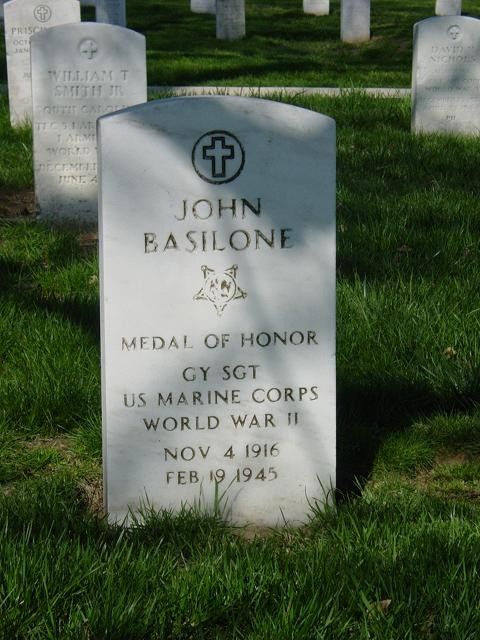
Having cleared a path for the troops on the beach, Basilone gathered several more Marines, set up a base of fire and ordered them to hold while he went back for more men and weapons. On his way, Basilone spotted three M4 Sherman tanks, their water-cooled V-8s grinding like hell as they struggled up the beach under heavy fire. Knowing their value for knocking out bunkers, Basilone immediately took over.
Sgt Adolph Brusa, a mortar squad leader, remembered he suddenly looked up and there was this lone Marine with those tanks, “And I said to myself, ’That’s John Basilone! What the hell is he doing, standing up when everybody else is hugging the ground?’
What Basilone was doing was guiding the tanks through a minefield and pointing out targets while completely exposed to the fire aimed at the Shermans. Brusa later recalled the lead tank had a painting of a crowned snake, and its name was King Cobra. The two following it were the Rattler and the Python all members of the Snake Platoon from Lieutenant Colonel William R. “Ripper” Collins’ 5th Tank Bn.
Leaving the tanks on high ground, Basilone returned to round up more troops for the assault team he had started building near the edge of Motoyama Airfield #1. To do this he’d have to re-cross the steep volcanic beach where he had met the tanks and where many Marines were still pinned down by Kuribayashi’s relentless shelling and well-camouflaged pillboxes.
Among those trying to reorganize their scattered units was Major (later Col) Justin G. Duryea of the 1st Bn, 27th Marines. Duryea, who would lose an arm in an enemy mine explosion on D+18, was so impressed by Basilone’s heroism that he later recommended him for a second Medal of Honor.
Basilone had landed with the fourth wave at approximately 0930. It was now almost noon and throughout the battle he had risked his life repeatedly, disregarding every danger, to restore momentum to the stalled attack. It seemed nothing could touch him, yet by ignoring fires that would eventually kill or wound thousands of men, Basilone had finally pushed his luck beyond its limits.
Many men have said they saw John Basilone fall on the beach, which he did not. One said Basilone’s legs were blown off by a mine. Several claim they heard Basilone’s final words, and one said Basilone begged to be put out of his misery with his own pistol.
Perhaps the most credible eyewitness is Roy Elsner the headquarters cook who had watched our machine-gun drills back in Pendleton and who was now on Iwo. He said that when he and some buddies were hunting for their headquarters: “A few hundred yards from Motoyama Field #1 we heard an explosion, which caused us to look a bit to our right [toward the field]. We saw Basilone and the three guys who were with him fall. We reached them almost immediately.”
Sometime after noon I came across a group of blackened bodies on the edge of Motoyama Airfield #1. Co C was advancing half a mile ahead, sweeping the flat field clean, when one of the dead caught my eye. He was a thin, pallid kid. His helmet was half off, and he lay face up, arched over his combat pack, with his jacket torn back and his mouth open. I vaguely recognized someone I had known in that lean, lifeless face beneath its dusty stubble of hair. ”That’s John Basilone,” said one of the men standing around. “He just got it.” ”That’s b—s—. I know Basilone. We were in the same company.” Someone else said, “That’s Basilone.” I walked around and asked, “Is this Basilone?” A guy I knew said, “Yeah. He was briefing his guys when a mortar scored a direct hit. It killed them all.” I went and studied the dead man closely, but I didn’t touch him. The shell had landed at his feet, sending shrapnel into his groin, neck and left arm. He looked incredibly thin like an undernourished kid, with his hands near his stomach as though it hurt. This was the hero of Guadalcanal, the joy of a nation, the pride of the Marines and my friend, Manila John Basilone. See: articles.latimes.com/2010/may/03/entertainment/la-et-basilone-20100503
(Editor's note: Any negative references to the Marine Corps will not be published in comments; this is history and we honor this man's contributions to no end... Semper fi Gunny Basilone)
=============================================== Bob O’Dowd is a former U.S. Marine with thirty years of experience on the east coast as an auditor, accountant, and financial manager with the Federal government. Half of that time was spent with the Defense Logistics Agency in Philadelphia. Originally from Pennsylvania, he enlisted in the Marine Corps at age 19, served in the 1st, 3rd, and 4th Marine Aircraft Wings in 52 months of active duty in the 1960s. A graduate of Temple University, Bob has been married to Grace for 31 years. He is the father of two adult children and the grandfather of two boys. Bob has a blog site on former MCAS El Toro at mwsg37.com. This subject is where Bob intersected with Salem-News.com. Bob served in the exact same Marine Aviation Squadron that Salem-News founder Tim King served in, twenty years earlier. With their combined on-site knowledge and research ability, Bob and Tim and a handful of other ex-Marines, have put the contamination of MCAS El Toro on the map. The base is highly contaminated with TCE, trichloroethelyne
Bob O’Dowd is a former U.S. Marine with thirty years of experience on the east coast as an auditor, accountant, and financial manager with the Federal government. Half of that time was spent with the Defense Logistics Agency in Philadelphia. Originally from Pennsylvania, he enlisted in the Marine Corps at age 19, served in the 1st, 3rd, and 4th Marine Aircraft Wings in 52 months of active duty in the 1960s. A graduate of Temple University, Bob has been married to Grace for 31 years. He is the father of two adult children and the grandfather of two boys. Bob has a blog site on former MCAS El Toro at mwsg37.com. This subject is where Bob intersected with Salem-News.com. Bob served in the exact same Marine Aviation Squadron that Salem-News founder Tim King served in, twenty years earlier. With their combined on-site knowledge and research ability, Bob and Tim and a handful of other ex-Marines, have put the contamination of MCAS El Toro on the map. The base is highly contaminated with TCE, trichloroethelyne
Articles for May 11, 2010 | Articles for May 12, 2010 | Articles for May 13, 2010
Quick Links
DINING
Willamette UniversityGoudy Commons Cafe
Dine on the Queen
Willamette Queen Sternwheeler
MUST SEE SALEM
Oregon Capitol ToursCapitol History Gateway
Willamette River Ride
Willamette Queen Sternwheeler
Historic Home Tours:
Deepwood Museum
The Bush House
Gaiety Hollow Garden
AUCTIONS - APPRAISALS
Auction Masters & AppraisalsCONSTRUCTION SERVICES
Roofing and ContractingSheridan, Ore.
ONLINE SHOPPING
Special Occasion DressesAdvertise with Salem-News
Contact:AdSales@Salem-News.com

googlec507860f6901db00.html



Terms of Service | Privacy Policy
All comments and messages are approved by people and self promotional links or unacceptable comments are denied.
Christine Brusa Meredith November 12, 2010 9:10 am (Pacific time)
My dear father is Adolph Brusa, quoted in this article.I have heard him say several times "John Basilone Was A God damned hero." and my dad doesn't take God's name in vain lightly!
Tim King: Christine, you have no idea how much this means to read this, we are HONORED to have you drop by. My email is <a href="mailto:tim@salem-news.com">tim@salem-news.com</a>
Lolla Þóra July 3, 2010 12:55 pm (Pacific time)
Hi there, can someone tell me where to look for realitives ? My grandfather died in the ww2 he was here in Iceland and my mom was born 1 mon after he died.(1944) I´m trying to look for his name´s but can not find anything :( If someone can tell me where best is to look please? Best regards Lolla ( Ólöf)
Dave S. May 16, 2010 9:34 pm (Pacific time)
Thank You Marines for my freedom and thank you John Basilone
Hermogenes Marrero May 13, 2010 6:24 am (Pacific time)
Marine Corps Values Honor, Courage, Commitment "Leading Marines" Generation after generation of American men and women have given special meaning to the term United States Marine. They have done so by their performance on and off the battlefield. Feared by enemies, respected by allies, and loved by the American people, Marines are a "special breed." This reputation was gained and is maintained by a set of enduring core values. these values form the cornerstone, the bedrock, and the heart of our character. They are the guiding beliefs and principles that give us strength, influence our attitudes, and regulate our behavior. They bond our Marine family into a total force that can meet any challenge. HONOR: Honor requires each Marine to exemplify the ultimate standard in ethical and moral conduct. Honor is many things; honor requires many things. A U.S. Marine must never lie, never cheat, never steal, but that is not enough. Much more is required. Each Marine must cling to an uncompromising code of personal integrity, accountable for his actions and holding others accountable for theirs. And, above all, honor mandates that a Marine never sully the reputation of his Corps. COURAGE: Simply stated, courage is honor in action -- and more. Courage is moral strength, the will to heed the inner voice of conscience, the will to do what is right regardless of the conduct of others. It is mental discipline, an adherence to a higher standard. Courage means willingness to take a stand for what is right in spite of adverse consequences. This courage, throughout the history of the Corps, has sustained Marines during the chaos, perils, and hardships of combat. And each day, it enables each Marine to look in the mirror -- and smile. COMMITMENT: Total dedication to Corps and Country. Gung-ho Marine teamwork. All for one, one for all. By whatever name or cliche, commitment is a combination of (1) selfless determination and (2) a relentless dedication to excellence. Marines never give up, never give in, never willingly accept second best. Excellence is always the goal. And, when their active duty days are over, Marines remain reserve Marines, retired Marines, or Marine veterans. There is no such thing as an ex-Marine or former-Marine. Once a Marine, always a Marine. Commitment never dies. The three Corps Values: honor, courage, commitment. They make up the bedrock of the character of each individual Marine. They are the foundation of his Corps. These three values, handed down from generation to generation, have made U.S. Marines the Warrior Elite. The U.S. Marine Corps: the most respected and revered fighting force on earth. Reaffirm these core values and ensure they guide your performance, behavior, and conduct every munute of every day.
Osotan; May 13, 2010 3:22 am (Pacific time)
Robert, did you notice the same expresssion on "Pappy" Boyingtons face in the photo of your earlier story on the "black sheep squadren"? Where do they get these guys?
Editor: Semper fi do or die!
Jim Davis, Veterans-For-Change May 12, 2010 11:37 pm (Pacific time)
AWESOME Article! Thanks!
G 2/3; May 12, 2010 6:04 pm (Pacific time)
Semper Fi god damn it!, marines never die, they just go to hell and re-assemble!
[Return to Top]©2025 Salem-News.com. All opinions expressed in this article are those of the author and do not necessarily reflect those of Salem-News.com.